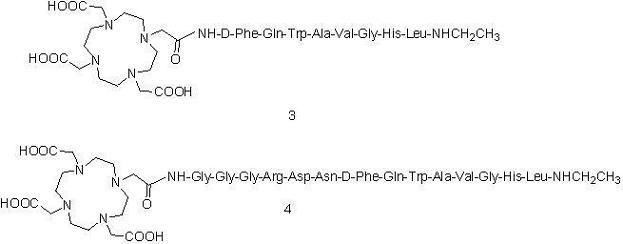A Peptide Modified Segment and Its Application in the Modification of Peptide Molecular Imaging Probes
A molecular probe, peptide modification technology, applied in the direction of peptides, radioactive carriers, etc., can solve the problems of difficult industrial production and unsatisfactory effects, and achieve the effect of increasing contrast, suitable for large-scale production, and optimizing imaging quality.
- Summary
- Abstract
- Description
- Claims
- Application Information
AI Technical Summary
Problems solved by technology
Method used
Image
Examples
Embodiment 1
[0029] Experimental principle:
[0030] Take the bombesin polypeptide derivative whose target is the gastrin-releasing peptide receptor as an example. The sequence is D-Phe-Gln-Trp-Ala-Val-Gly-His-Leu-NHCH 2 CH 3 Peptides with gastrin-releasing peptide receptor targeting, can be combined with positron nuclides (such as 18 F, 68 Ga) labeling precursor 18 F-2-Fluorophenylpropionic acid, prepared by the reaction of chelating agent DOTA 18 F, 68 Ga-labeled peptide molecular imaging probes 1 and 3 were used for PET imaging, or reacted with near-infrared fluorescence imaging nuclide cy5.5 to prepare cy5.5-labeled peptide molecular imaging probe 5 for optical imaging. Peptide Molecules Imaging probes 1, 3, and 5 have poor imaging effects, and they can be modified by inserting the peptide-modified segment Gly-Gly-Gly-Arg-Asp-Asn into D-Phe-Gln-Trp-Ala-Val- Gly-His-Leu-NHCH 2 CH 3 and imaging part 18 Modified peptide molecular imaging probes prepared between F-2-fluorophenylp...
PUM
 Login to View More
Login to View More Abstract
Description
Claims
Application Information
 Login to View More
Login to View More - R&D
- Intellectual Property
- Life Sciences
- Materials
- Tech Scout
- Unparalleled Data Quality
- Higher Quality Content
- 60% Fewer Hallucinations
Browse by: Latest US Patents, China's latest patents, Technical Efficacy Thesaurus, Application Domain, Technology Topic, Popular Technical Reports.
© 2025 PatSnap. All rights reserved.Legal|Privacy policy|Modern Slavery Act Transparency Statement|Sitemap|About US| Contact US: help@patsnap.com



